Antoinette Farnsworth Drew, 1865-1941
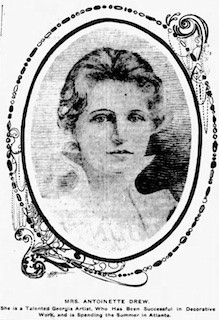
Antoinette Farnsworth Drew was born on August 28, 1865 in Fond du Lac, Wisconsin (according to her passport application; her grave marks 1864; newspaper accounts state 1866). According to Find a Grave, she married a certain Talma Drew in May, 1887. Her parents moved to Atlanta, where her father, William Farnsworth, was a contractor. Her passport application, approved in January 1893, lists her occupation as artist living in Washington D.C.
Antoinette traveled to Paris in 1893 (presumably without her husband) where she resided at the Girls’ Art Club. She exhibited a pastel, “Portrait de Mlle H...” at the 1896 Salon des artistes français and a painting at the 1898 Salon des artistes français; both times, she listed her address as 4 rue de Chevreuse. From all accounts, she lived in Florence and Venice, but spent the majority of her life abroad in Paris, where she studied at Academies Julian by day and Colarossi by night, under Benjamin Constant and Jean Paul Lawrence. In a 1901 interview by Mary Alice Phillips for the Atlanta Journal, Antoinette evoked those early years abroad:
At Colarossi, I found life very hard. The men resented the invasion of women and resorted to all sorts of devices to keep them away; the most telling of these was relating ugly jokes to one another. The sweet girl artist usually fled – the type that never gets beyond the “sweet-picture” stage. [...] When I first went to Paris, I boarded at a swell boarding-house and went to Juliens (sic) at fashionable hours, but I soon learned that if I wished to accomplish anything, I must have a studio. For beauty and general comfort these studios are not altogether successes. With a top and two sides glass, when the weather is cold and rainy one might as well be out of doors (16).
Having returned to the U.S. sometime in 1899, Antoinette first stayed in New York City but spent several summer months 1901 in Atlanta, Georgia, where she established a studio in the home of a certain Mrs. Bennett (The Atlanta Journal, July 13, 1901, p. 16). That same year, Lights of Childland, a children's book by Maud Ballington Booth and illustrated by Drew, was published by G.P. Putman & Sons:
The book is profusely illustrated [...]. These illustrations are themselves worthy of note, for they show a keen, clear, group of the writer’s thought and are very attractive. [...] She is specifically a portrait painter, but undertook the illustration of this book and several others [...] as a rest from the burden of her chosen life (The Atlanta Journal, November 2, 1901, p. 18).
In 1902, she also began writing and illustrating her own stories for boys.
Antoinette resided in New York City, where she had a studio for nine years and designed stained glass windows for J.R. Lamb studios and also worked for Tiffany’s. There is no mention of her husband in newspaper accounts of that period; he died in 1909.
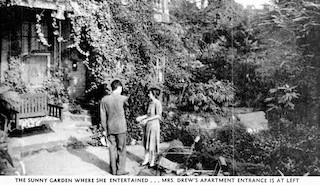
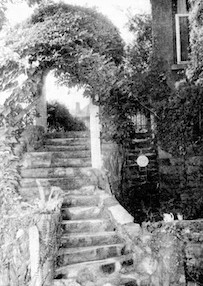
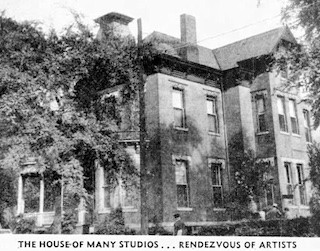
Her aunt, whom she had nursed several years prior to her death in 1922, bequeathed two properties to Antoinette, including the three-story, red brick “castle house” where she had spent much of her Atlanta childhood. Because relatives contested the will, Antoinette was only granted ownership by court order in 1924. She made it her home until her untimely death in 1941. She carefully hand-crafted the garden – a creative act she likened to painting – and gathered many fellow artists and art dealers to her home. In the thirties, she lent the second floor of her residence to the Studio Club of the Atlanta Art Group (The Atlanta Constitution, September 21, 1941, p. 49). In later years, when arthritis prevented her from painting, she rented rooms in her house to struggling artists, and provided meals for down and out wanderers in exchange for the upkeep of her garden.
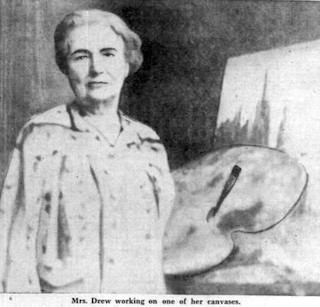
Her artistic legacy is difficult to unearth, though she was known for her stained glass and her seascapes of Bar Harbor, and especially those in in Nova Scotia, where she stayed on a yearly basis. She also painted a mural in the children’s ward of Atlanta’s Grady Hospital and another, “Dawn of Learning,” in the reference room of the Carnegie Library (presented by the WPA arts project).
News articles are scant about her life and travels in the 1930s, but her name surfaces again at the end of her life. Newspaper accounts that chronicled her shocking killing – the mystery of which was never fully unraveled – identified robbery as the primary motive: either by a carpenter who worked for her as a handyman or by a homeless person with whom she had quarreled over money. The Atlanta Journal best described the scene of desolation:
The quaint old red brick mansion at 88 Ellis Street, N.E., where sunken gardens grow green in the shadows of Peachtree’s skyscrapers, was a mystery house today, holding in its gloomy basement studio behind a sunny patio the secret of the murder of its mistress. It was here that Mrs. Antoinette Farnsworth Drew, aging with the canvases that made her famous, lived among the people she loved – ambitious young artists and dealers in art – living and breathing the work that her gnarled old hands could no longer do. It was here, too, that the grand old lady died. Saturday or Sunday, at the hands of the one who stole into her studio apartment and bludgeoned her with a pickax as she lay in bed. Police who investigated the cold trail found the death weapon still bloodstained, and a basement window where the screen had been ripped away (September 17, 1941, p. 23).
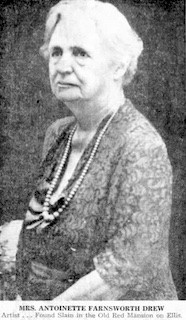
Identified as the matriarch of the Atlanta art colony and an active member of the Atlanta Art Association, Antoinette had always dreamed that her house would become a center for artists, dream that came true in c. 1947 when Ernest Felber and Mrs. William Elsas opened The Gallery at 88 Ellis, which exhibited fine art from the world over until about 1953. The house was destroyed sometime in the 1960s, after having served as a private home.
A 2022 podcast by the Atlanta Archive sheds some light on Antoinette Farnworth Drew: "[...[ the little we know about her life, her artwork and the story of her unsolved murder. History is often unkind to women, and at best has simply forgotten their names and achievements. This is especially true for women that don’t reach national fame and/or those that don’t have descendants to carry on their memory. Both of these are true for Antoinette."